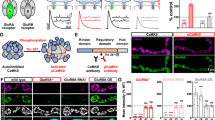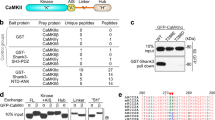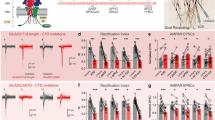Abstract
The idea that calcium/calmodulin-dependent protein kinase II (CaMKII) is strategically localized to excitatory synapses to exert its important role in long-term potentiation and other forms of neuronal plasticity1 is supported by the binding of CaMKII to isolated postsynaptic densities (PSD) in biochemical assays2 and by the finding in cultured neurons that PSD clusters of green fluorescent protein (GFP)-tagged CaMKII form in response to glutamate application or direct electrical stimulation3,4. The observation that CaMKII also forms large clusters in response to ischemic insults5, however, questions the physiological relevance of such translocations. Here we show that in intact zebrafish, repeated sensory stimulation resulted in reproducible and reversible translocation of GFP-CaMKII to the PSD in an identified interneuron in a sensorimotor circuit.
This is a preview of subscription content, access via your institution
Access options
Subscribe to this journal
Receive 12 print issues and online access
$209.00 per year
only $17.42 per issue
Buy this article
- Purchase on Springer Link
- Instant access to full article PDF
Prices may be subject to local taxes which are calculated during checkout



Similar content being viewed by others
References
Elgersma, Y. et al. Neuron 36, 493–505 (2002).
Strack, S., Choi, S., Lovinger, D.M. & Colbran, R.J. J. Biol. Chem. 272, 13467–13470 (1997).
Shen, K. & Meyer, T. Science 284, 162–166 (1999).
Shen, K., Teruel, M.N., Connor, J.H., Shenolikar, S. & Meyer, T. Nat. Neurosci. 3, 881–886 (2000).
Dosemeci, A., Reese, T.S., Petersen, J. & Tao-Cheng, J-H. J. Neurosci. 20, 3076–3084 (2000).
Higashijima, S., Okamoto, H., Ueno, N., Hotta, Y. & Eguchi, G. Dev. Biol. 192, 289–299 (1997).
Park, H.C. et al. Dev. Biol. 227, 279–293 (2000).
Bernhardt, R.R., Chitnis, A.B., Lindamer, L. & Kuwada, J.Y. J. Comp. Neurol. 302, 603–616 (1990).
Hale, M.E., Ritter, D.A. & Fetcho, J.R. J. Comp Neurol. 437, 1–16 (2001).
Clarke, J.D.W., Hayes, B.P., Hunt, S.P. & Roberts, A. J. Physiol. 348, 511–525 (1984).
Roberts, A. & Sillar, K.T. Eur. J. Neurosci. 2, 1051–1062 (1990).
Sillar, K.T. & Roberts, A. Nature 331, 262–265 (1988).
Acknowledgements
We thank P. Brehm (SUNY Stony Brook) for technical advice, T. Meyer (Stanford) for rat CaMKIIα cDNA and M. Sheng (MIT) for human PSD95 cDNA. M.R.G. is a recipient of a predoctoral fellowship from the National Science Foundation. S.H. is supported by a grant from the Toyobo Biotechnology Foundation. G.M. is an investigator of the Howard Hughes Medical Institute. This work was also supported by National Institutes of Health grant NS26539 to J.R.F.
Author information
Authors and Affiliations
Corresponding author
Ethics declarations
Competing interests
The authors declare no competing financial interests.
Supplementary information
Supplementary Movie 1.
CaMKII black and white movie: This is a movie of the experiment shown in Figure 1 B in which GFP-CaMKII was expressed in a CoPA neuron. The stimulation leads to translocation of the GFP-CaMKII. The movement artifact occurs at the time of the stimulus. (MOV 614 kb)
Supplementary Movie 2.
CaMKII three color movie: This is a movie of the experiment shown in Figure 1 C in which both DsRed and GFP-CaMKII were expressed in a CoPA neuron. The movie shows from top to bottom, the DsRed channel, the GFP-CaMKII channel and an overlay of the two. The stimulation leads to translocation of the GFP-CaMKII, but not the DsRed. Small movements at the beginning of the sequence are the result of the fish attempting to swim. A large movement artifact occurs at the time of the stimulus. (MOV 1295 kb)
Supplementary Movie 3.
CaMKII dual label: This shows a larger view of the overlay image from the dual labeling channel in movie number 2. (MOV 727 kb)
Rights and permissions
About this article
Cite this article
Gleason, M., Higashijima, Si., Dallman, J. et al. Translocation of CaM kinase II to synaptic sites in vivo. Nat Neurosci 6, 217–218 (2003). https://doi.org/10.1038/nn1011
Received:
Accepted:
Published:
Issue Date:
DOI: https://doi.org/10.1038/nn1011
This article is cited by
-
Position- and quantity-dependent responses in zebrafish turning behavior
Scientific Reports (2016)
-
The histidine triad nucleotide-binding protein 1 supports mu-opioid receptor–glutamate NMDA receptor cross-regulation
Cellular and Molecular Life Sciences (2011)
-
Regulatory mechanisms of AMPA receptors in synaptic plasticity
Nature Reviews Neuroscience (2007)
-
In vivo imaging of synapse formation on a growing dendritic arbor
Nature Neuroscience (2004)



